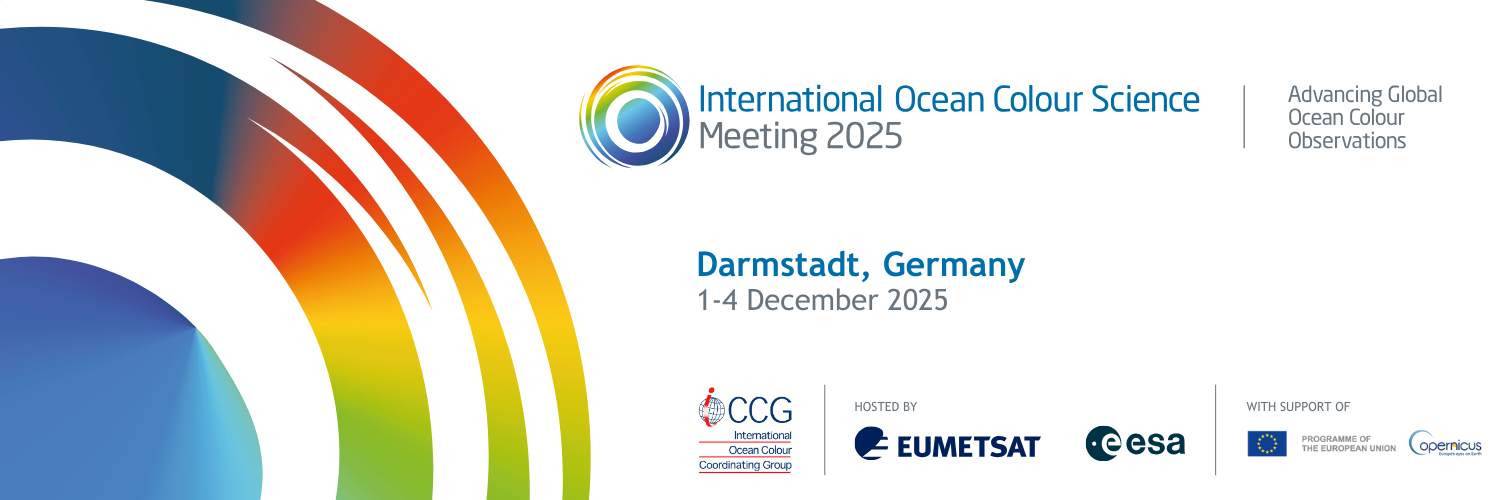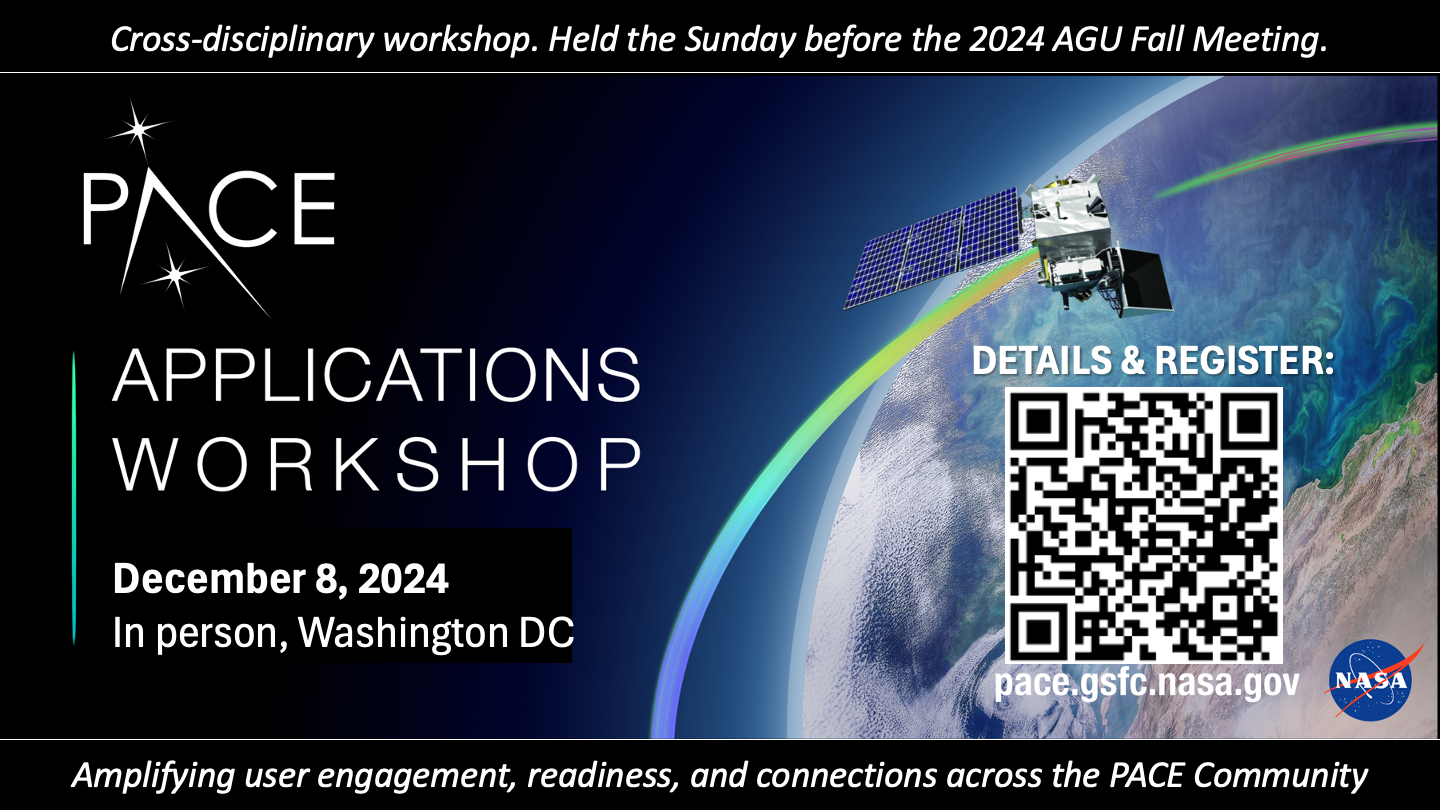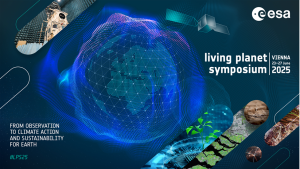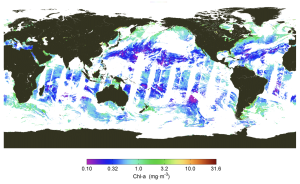IOCCG news bulletins include items of interest from the IOCCG, its sponsoring agencies, and the broader ocean colour community. Please let us know if there are any other items of interest you would like to see included in the next IOCCG news bulletin by contacting Raisha Lovindeer (raisha@ioccg.org).
News from IOCCG
IOCS-2025 Save the Date!
The International Ocean Colour Science (IOCS) meeting, for optical radiometry of all water types, serves as a venue for open communication between the scientific community and the space agencies. The meeting is structured around consensus recommendations to the agencies that will help to inform future missions, and drive forward science and application. It also provides a venue for the community to liaise directly with representatives from the respective agencies.
 The 6th IOCS will take place from 1 – 4 December 2025 at the Darmstadtium in Darmstadt, Germany, under the theme: Ocean Colour: serving Earth system science & our society. Associated short courses will be held on 5 December 2025. The meeting is convened by the IOCCG, hosted by The European Organisation for the Exploitation of Meteorological Satellites (EUMETSAT), the European Space Administration (ESA), with the support of the Copernicus Programme from the European Commission.
The 6th IOCS will take place from 1 – 4 December 2025 at the Darmstadtium in Darmstadt, Germany, under the theme: Ocean Colour: serving Earth system science & our society. Associated short courses will be held on 5 December 2025. The meeting is convened by the IOCCG, hosted by The European Organisation for the Exploitation of Meteorological Satellites (EUMETSAT), the European Space Administration (ESA), with the support of the Copernicus Programme from the European Commission.
Subscribe to the IOCCG mailing list for future announcements about the meeting.
Expressions of interest for associated training sessions or side meetings can be directed to raisha@ioccg.org, copied to iocs@eumetsat.int.
2025 IOCCG Platt Scholarship closing soon, on November 12
The IOCCG Platt Scholarship provides one national of a developing country or economy in transition with the opportunity to conduct valuable research or training in the field of ocean and in-land water remote sensing and applications in an institution outside of their home country. Applications for the 2025 IOCCG Platt Scholarship opened on 12 August 2024 and will close on 12 November 2024. See the scholarship webpage for details.
Reminder of Open Call for IOCCG Working Group & Task Force Proposals
A reminder that IOCCG welcomes submissions of proposals for working groups and task forces that aim to address OPEN community recommendations from the IOCS meetings. Proposals for working groups should outline a plan for an IOCCG Scientific Report as the output, to be completed within 2-3 years (see example), whereas proposals for task forces should outline on-goping actions for implementation across 3 or more years or until the need for the task force no longer exists. Proposals are accepted on a rolling basis, however those wishing to be reviewed and considered before the next IOCCG Committee meeting should be submitted no later than 31 December 2024.
Reminder of Open Call for Expressions of Interest for White Paper Leads
(linked to the US Decadal Survey 2027/28)
Through the IOCCG reports and the breakout sessions at the IOCS meetings, the ocean colour community has made many recommendations over the years about what is needed from future ocean colour satellite missions. This has been a key component of planning future missions for many of the space agencies. For the USA, these recommendations feed into the US Decadal Survey, conducted by the National Academies (for context, see recently published mid-term review of the last (2017) US Decadal Survey).
In an effort to maintain ocean colour science and missions in future planning and funding from satellite agencies, including in the next US Decadal Survey, we wish to have a clearinghouse for ocean colour white papers from the community.
IOCCG currently requests expressions of interest under topics of relevance for future satellite ocean colour missions from individuals or small teams wishing to lead the drafting of a white paper. Drafting of a white paper will include synthesizing the existing recommendations and gaps under your particular topic, and adding in relevant supporting material. Those interested in leading or contributing to drafting a white paper should register interest by emailing the IOCCG Project Coordinator (raisha@ioccg.org) at any time, preferably before the end of 2024.
News from NASA
PACE Applications Workshop: Putting PACE data to work across the Earth System
 The PACE Applications Workshop: Putting PACE data to work across the Earth System will be held on 8 December 2024, from 9am to 5pm, in Washington DC. It is a free, in person event, held the Sunday before the 2024 AGU Fall Meeting in Washington DC. Workshop content and attendance will be cross-disciplinary, spanning atmospheric, terrestrial, and aquatic domains. The goal is to amplify user engagement and readiness, as well as build connections across the PACE community of practitioners. The event is open to existing PACE data users and those interested in PACE data. Join for this informative and interactive event! Seats are limited, register today! Please visit the workshop webpage for the agenda, further details, and registration information.
The PACE Applications Workshop: Putting PACE data to work across the Earth System will be held on 8 December 2024, from 9am to 5pm, in Washington DC. It is a free, in person event, held the Sunday before the 2024 AGU Fall Meeting in Washington DC. Workshop content and attendance will be cross-disciplinary, spanning atmospheric, terrestrial, and aquatic domains. The goal is to amplify user engagement and readiness, as well as build connections across the PACE community of practitioners. The event is open to existing PACE data users and those interested in PACE data. Join for this informative and interactive event! Seats are limited, register today! Please visit the workshop webpage for the agenda, further details, and registration information.
2024 Virtual GLIMR Annual Science and Applications Team Meeting
The Geostationary Littoral Imaging and Monitoring Radiometer (GLIMR) mission had its annual team meeting between 22 and 23 October 2024, where team members and other stakeholders presented the current status of the instrument, data collection and processing flow, its unique science and application topics, and societal values. GLIMR is the first hyperspectral mission on a geostationary orbit, with a tentative position at 98 degrees west. The team also discussed the sampling plans including the trade space between spatial and temporal coverage.
NASA MarONet first deployment off Perth

Divers getting wet checking MarONet. The yellow marker buoy on the front is the main mooring to which the MarONet buoy (in the background) is tethered.
On 17 September 2024, the first element of the Marine Optical Network (MarONet) was deployed 26 nm off Perth, Western Australia. MarONet is funded by NASA to support the System Vicarious Calibration activities for the PACE mission. MarONet is derived from, and nearly identical to, the MOBY Refresh system, the deployment of which is in Hawaii being supported by NOAA. The quality of the data that have started to flow is excellent, and the first of the monthly servicing cruises happened on 24 October, with a contribution from the Commonwealth Scientific and Industrial Research Organisation (CSIRO) for ship time and diving. Data are available at NASA’s Ocean Biology DAAC (oceancolor.gsfc.nasa.gov) at full spectral resolution and at NOAA’s CoastWatch (coastwatch.noaa.gov) weighted by satellite sensor spectral response.
The MarONet activity is led by University of Miami (PIs Art Gleason and Ken Voss), with contributions from San Jose State University – Moss Landing Marine laboratories (PI Mark Yarbrough), the National Institute of Standards and Technology in the USA (NIST; PI Carol Johnson), and the Curtin University Remote Sensing and Satellite Research Group in Perth (PI David Antoine). Planning is underway for the first buoy swap to happen in the first quarter of 2025. Contact the MarONet PI for more information at agleason@miami.edu
News from ESA
Biodiversity Insights from Space: BIOSPACE25 Conference
 BIOSPACE25 is the first international conference exclusively dedicated to the application of Satellite Remote Sensing (SRS) across the various dimensions of biodiversity, and addressing the use of Earth Observations in all realms, from terrestrial, freshwater, coastal to marine ecosystems. It is the first edition of a series of BIOSPACE conferences that ESA and its partners intend to organise on a regular basis and which aim to bring together an interdisciplinary and cross-sectoral community of experts in biodiversity and conservation, made of specialists in satellite remote sensing for biodiversity, biodiversity scientists, field ecologists, biodiversity monitoring practitioners, data providers and biodiversity policy stakeholders from governments, international organizations and NGOs.
BIOSPACE25 is the first international conference exclusively dedicated to the application of Satellite Remote Sensing (SRS) across the various dimensions of biodiversity, and addressing the use of Earth Observations in all realms, from terrestrial, freshwater, coastal to marine ecosystems. It is the first edition of a series of BIOSPACE conferences that ESA and its partners intend to organise on a regular basis and which aim to bring together an interdisciplinary and cross-sectoral community of experts in biodiversity and conservation, made of specialists in satellite remote sensing for biodiversity, biodiversity scientists, field ecologists, biodiversity monitoring practitioners, data providers and biodiversity policy stakeholders from governments, international organizations and NGOs.
The goal of the BIOSPACE conferences is to offer insightful exploration of critical biodiversity challenges that Earth Observation systems should primarily address, to showcase cutting-edge SRS solutions in different biodiversity domains, and to foster collaborative efforts to advance the use and impact of Earth Observation in biodiversity science, monitoring and policy implementation.
The deadline for submission of abstracts and workshops has been extended to 3 November 2024. Read more on the conference website: https://biospace25.esa.int.
Living Planet Symposium
 The next ESA Living Planet Symposium will take place in Vienna, Austria from 23-27 June 2025. The LPS25 website is now live at https://lps25.esa.int/ and with it, the Abstract Submission is now open until 1 December 2024.
The next ESA Living Planet Symposium will take place in Vienna, Austria from 23-27 June 2025. The LPS25 website is now live at https://lps25.esa.int/ and with it, the Abstract Submission is now open until 1 December 2024.
You are invited to submit abstracts in response to the proposed sessions. All submitted abstracts will be reviewed by the Scientific Committee, with final decisions made by the session convenors.
News from EC-JRC
5th Workshop on HPLC Phytoplankton Pigments Intercomparisons (HIP)
Since 2009, the European Commission Joint Research Centre (JRC) has regularly organised intercomparison exercises on HPLC Phytoplankton Pigments (HIP) analysis to support the validation of satellite data products. The last four intercomparisons were organized with the general objective of supporting the validation of marine phytoplankton data products from Copernicus Sentinel-3 missions.
This year, the JRC hosts the 5th edition of the HPLC Phytoplankton Pigments Intercomparisons (HIP) Workshop. The workshop will take place on 3 – 4 December 2024 at the Joint Research Centre of the European Commission in Ispra, Italy, and will be a hybrid event. The workshop will also present and discuss the results of the last HPLC phytoplankton pigment analysis (HIP-8) and plan future intercomparison activities. It is an opportunity to expand the network of researchers whose activities focus on marine pigment analysis in support of satellite data and bio-optical algorithm validation.
Where: Joint Research Centre, Via E. Fermi, 1219, 21027 Ispra VA, Italy (hybrid)
When: 3-4 December 2024, 09:00 -18:00 (CEST)
Requests for participation should be submitted to Elisabetta Canuti (JRC-HIP-workshop@ec.europa.eu) by 15 November 2024. Visit the work
News from MNR, China
China’s new generation ocean color satellite has completed its on-orbit testing

Daily composited product of Chlorophyll-a concentration from COCTS2 on China’s new generation ocean color satellite (October 20, 2024)
China’s new generation ocean color satellite has completed its on-orbit testing on 30 September 2024. The satellite was successfully launched on 16 November 2023, and was equipped with three major payloads, including the second generation Chinese Ocean Color and Temperature Scanner (COCTS2), the second generation Coastal Zone Imager (CZI2) and the Programmable Medium Resolution Imaging Spectrometer (PMRIS). The satellite can observe daily global ocean color and sea surface temperature with multispectral bands from 360nm to 12µm, a spatial resolution of 500 meters, and a swath width of about 3200 kilometers.
After 9-month on-orbit testing, the products of the satellite are ready to be released, including the level 1 (TOA radiance), Level 2 (remote sensing reflectance after atmospheric correction, Chlorophyll-a concentration, sea surface temperature, etc.) and Level 3 (daily, 8-day and monthly composited) products. After the official release, users can query and download the corresponding products from China’s Ocean Satellites Data Distribution System (https://osdds.nsoas.org.cn/home).
News from SCOR
Call for 2025 SCOR Visiting Scholar
 The Scientific Committee on Oceanic Research (SCOR) Visiting Scholar program enlists the services of ocean scientists, from developed countries and developing countries, to teach short courses and to provide more extended on-site education and mentorship at developing country institutions.
The Scientific Committee on Oceanic Research (SCOR) Visiting Scholar program enlists the services of ocean scientists, from developed countries and developing countries, to teach short courses and to provide more extended on-site education and mentorship at developing country institutions.
This program is open to any scientists who have time available to spend teaching and mentoring in a developing country for ideally two weeks or more. Scholarships are $2500 USD and are not intended to conduct joint research, although future collaborations are a desirable outcome of a visit.
Applications will be reviewed by the SCOR Capacity Development Committee based on criteria outlined on the SCOR Visiting Scholar web page
The deadline for applications is 16 December 2024. Applications should be sent to secretariat@scor-int.org
Employment Opportunities
Several new research and employment positions have been added to the Employment Opportunities section on the IOCCG website, including:
- PhD Opportunities, UQAR & Laval University, Quebec, Canada
- Postdoctoral Position, Laboratory of Oceanology and Geosciences, Wimereux, France
- Postdoc Research Fellowship, University of Victoria, British Columbia, Canada
- Postdoctoral Scholars, Scripps Institute of Oceanography, San Diego, CA, USA
- Assistant Professor positions, Boston University, Boston, MA, USA
If you would like to include a position on this page, please contact Raisha Lovindeer.


 The sixth International Ocean Colour Science (IOCS) meeting will take place in Darmstadt, Germany from 1 – 4 December 2025, hosted by EUMETSAT and ESA with support from other agencies.
The sixth International Ocean Colour Science (IOCS) meeting will take place in Darmstadt, Germany from 1 – 4 December 2025, hosted by EUMETSAT and ESA with support from other agencies.